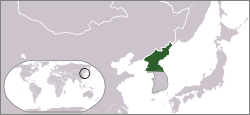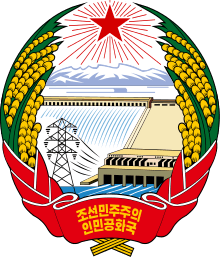Provisional People's Committee for North Korea
| Provisional People’s Committee for North Korea | ||||||||||||
| 북조선인민위원회 Pukchosǒn Inmin Wiwŏnhoe | ||||||||||||
| ||||||||||||
| ||||||||||||
| Anthem Aegukka 애국가 "Patriotic Song" | ||||||||||||
 Location of North Korea. | ||||||||||||
| Capital | Pyongyang | |||||||||||
| Languages | Korean | |||||||||||
| Religion | Cheondoism, Shamanisma | |||||||||||
| Government | Unitary Marxist–Leninist one-party socialist state | |||||||||||
| Chairmanb | ||||||||||||
| • | 1946–1948 | Kim Tu-bong | ||||||||||
| Chairmanc | ||||||||||||
| • | 1946–1948 | Kim Il-sung | ||||||||||
| Legislature | People's Assembly[1] | |||||||||||
| Historical era | Cold War | |||||||||||
| • | Formation | 8 February 1946 | ||||||||||
| • | Democratic People's Republic of Korea proclaimed | 9 September 1948 | ||||||||||
| Currency | Korean yen[2] (1946–1947) North Korean won (1947–1948) | |||||||||||
| ||||||||||||
| ^a See Religion in North Korea. ^b As "Chairman of the Central Committee". ^c As "Chairman of the Provisional People's Committee". | ||||||||||||
Part of a series on the |
||||||||||||||||||||||||||||||||
|---|---|---|---|---|---|---|---|---|---|---|---|---|---|---|---|---|---|---|---|---|---|---|---|---|---|---|---|---|---|---|---|---|
| History of North Korea | ||||||||||||||||||||||||||||||||
 | ||||||||||||||||||||||||||||||||
|
||||||||||||||||||||||||||||||||
|
| ||||||||||||||||||||||||||||||||
The Provisional People’s Committee for North Korea[3] (Chosŏn'gŭl: 북조선인민위원회, Hancha: 北朝鮮人民委員會, Revised Romanization: Bukjoseon Inmin Wiwonhoe, McCune–Reischauer: Pukchosǒn Inmin Wiwŏnhoe) was the official name of the provisional government governing the northern portion of the Korean Peninsula following its post-World War II partition by the United States and the Soviet Union after the defeat of the Empire of Japan in 1945. Soviet forces had seized and occupied the northern portion of Korea from the Japanese during World War II, while the Americans had managed to seize the southern portion from the Japanese. In the north, a pro-Soviet, ideologically communist government was established, officially succeeding a quasi-government composed of five provinces in 1946. The government was largely modeled after the Soviet Union.
Establishment
In February 1946, the provisional government was formed under Kim Il-sung, who had spent the last years of the war training with Soviet troops in Manchuria. Conflicts and power struggles rose up at the top levels of government in Pyongyang as different aspirants maneuvered to gain positions of power in the new government. At the local levels, people's committees openly attacked collaborators and some landlords, confiscating much of their land and possessions. As a consequence many collaborators and others disappeared or were assassinated. It was out in the provinces and by working with these same people's committees that the eventual leader of North Korea, Kim Il-sung, was able to build a grassroots support system that would lift him to power over his political rivals who had stayed in Pyongyang. Throughout August Koreans organized throughout the country into people committees branches for the "Committee for the Preparation of Korean Independence" (CPKI, 건국준비위원회, 建國準備委員會). The Soviet Army allowed these committees to continue to function since they were friendly to the Soviet Union, but still established the Soviet Civil Administration to begin to centralize the independent committees. Further provisional committees were set up across the country putting Communists into key positions.
Reforms
In March 1946, the land reform was instituted, as the land from Japanese and collaborator land owners was divided and handed over to poor farmers. Kim Il-sung initiated a sweeping land reform program in 1946. Organizing the many poor civilians and agricultural laborers under the people's committees, a nationwide mass campaign broke the control of the old landed classes. Landlords were allowed to keep only the same amount of land as poor civilians who had once rented their land, thereby making for a far more equal distribution of land. The North Korean land reform was achieved in a less violent way than that of the People's Republic of China or Vietnam. Official American sources stated, "From all accounts, the former village leaders were eliminated as a political force without resort to bloodshed, but extreme care was taken to preclude their return to power."[4] This was very popular with the farmers, but caused many collaborators and former landowners to flee to the south where some of them obtained positions in the new South Korean government. According to the U.S. military government, 400,000 northern Koreans went south as refugees.[5]
Key industries were nationalized. The economic situation was nearly as difficult in the north as it was in the south, as the Japanese had concentrated agriculture in the south and heavy industry in the north.
Dissolution
The Democratic People's Republic of Korea was proclaimed on September 9, 1948, effectively dissolving the provisional government. Soviet forces departed from North Korea in 1948.
See also
- Division of Korea#Soviet occupation of North Korea
- Soviet Civil Administration
- Korea under Japanese rule
- Provisional Government of the Republic of Korea
- United States Army Military Government in Korea
- People's Republic of Korea
- Korean War
References
- ↑ Korea – The Northern Zone
- ↑ Cho, Lee-Jay; Kim, Yoon Hyung (1995). Economic systems in South and North Korea: the agenda for economic integration. Korea Development Institute. p. 161. ISBN 978-89-8063-001-1.
- ↑ "Provisional People's Committee for North Korea". Encyclopædia Britannica.
- ↑ Cumings, Bruce. The Origins of the Korean War: Liberation and the Emergence of Separate Regimes, 1945-1947. Princeton University Press, 1981, 607 pages, ISBN 0-691-09383-0.
- ↑ Allan R. Millet, The War for Korea: 1945-1950 (2005) p. 59.

%2C_black%26white.png)